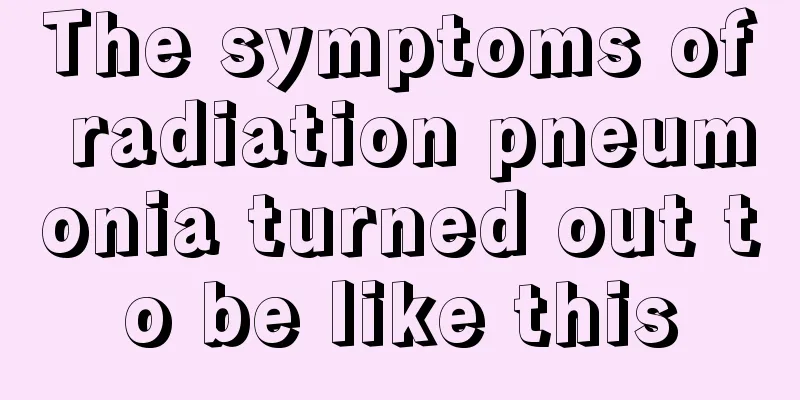The symptoms of radiation pneumonia turned out to be like this

|
Radiation pneumonitis is a form of pneumonia that results from inflammation caused by damage to lung tissue following radiation therapy for a malignant tumor. So what are the symptoms of radiation pneumonitis? Most people don't really understand this. In fact, patients with mild radiation pneumonia have no symptoms, while patients with more severe cases will show symptoms such as dry cough, palpitations, and chest pain. Clinical manifestations In mild cases, there are no symptoms. Symptoms usually appear 2 to 3 weeks after radiotherapy, often with an irritating, dry cough, accompanied by shortness of breath, palpitations and chest pain, no fever or low fever, and occasionally high fever. Shortness of breath progressively worsens with the worsening of pulmonary fibrosis, which can easily lead to respiratory infections and aggravate respiratory symptoms. Dysphagia may occur when radiation esophagitis occurs. If radiation damages the ribs, rib fractures will occur, with obvious tenderness in the local area. Physical examination revealed atrophy and hardening of the skin in the irradiated area, and dry and moist rales and friction sounds were heard in the lungs. Extensive and severe pulmonary fibrosis eventually leads to high lung function and cor pulmonale, with corresponding signs. Testing Changes in lung function: Both radiation pneumonitis and fibrosis cause restrictive ventilation dysfunction, decreased lung compliance, accompanied by a decreased ventilation/blood flow ratio and decreased diffusion function, leading to hypoxia. Sometimes lung function tests show changes even though a chest x-ray may not reveal any abnormalities. X-ray manifestations: Most cases develop shadows in the lungs one month after stopping radiotherapy. In the acute phase, warm, flake-like, blurred shadows appear on the irradiated lung field, with faint reticular shadows in between, which resemble bronchopneumonia or pulmonary edema. The range of the lesion is consistent with the irradiation field of the chest surface. Chronic pulmonary fibrosis occurs, presenting as cord-like or mass-like contraction or localized atelectasis. There are a lot of adhesions between the mediastinal pleura and pericardium, the mediastinum is displaced to the affected side, the ipsilateral diaphragm is elevated, and the chest collapses. prevention The key to the prevention and treatment of radiation pneumonitis lies in "prevention"; the key to "prevention" lies in the following three points: (1) Strictly control the radiation dose: generally, a conventional dose of 2500 rad within 5 weeks is relatively safe. (2) Control the radiation field. The larger the radiation field, the higher the incidence rate. (3) Choose an appropriate irradiation rate with a weekly dose of 800-1000 rad. Once the disease is discovered, treatment should be started as soon as possible to block the progression of the disease. If extensive pulmonary fibrosis has occurred, the prognosis is poor. |
<<: This is what AIDS rash looks like
>>: It turns out that there are these dos and don'ts in the diet for pulmonary arterial hypertension
Recommend
What are the dangers of adults and babies sharing tableware?
Many young parents lack experience and due to the...
What tests are done in the six-week follow-up after single thyroidectomy?
Six weeks after thyroid cancer resection, a follo...
Why do people get goose bumps?
Goose bumps are a skin condition that people are ...
How to check for ulcerative gastric cancer
Gastric cancer is a relatively harmful disease th...
Is TCM effective in treating liver cancer? What are the advantages of TCM in treating liver cancer?
The liver has metabolic functions and can excrete...
How to treat acute gout?
There seem to be more and more diseases in societ...
Be careful if you have these symptoms as they are signs of stomach cancer
Gastric cancer is one of the more common cancers....
How to massage to remove dark circles
Nowadays, basically many young people have the ha...
What are the ways hepatitis C is transmitted?
Hepatitis C is a contagious disease, so if you wa...
Late recurrence of endometrial cancer
How long does it take for endometrial cancer to r...
Can cicada shells cure insomnia? It works wonders!
Insomnia troubles countless office workers. If yo...
Can glioma really be cured?
Gliomas are neurological malignant brain tumors. ...
What are the symptoms when a baby sprains his back?
Parents need to be extra careful when their babie...
Anti-radiation clothes
Radiation is everywhere in our lives. TV series, ...
Main treatments for skin cancer
Skin cancer is one of many tumor diseases. If you...









